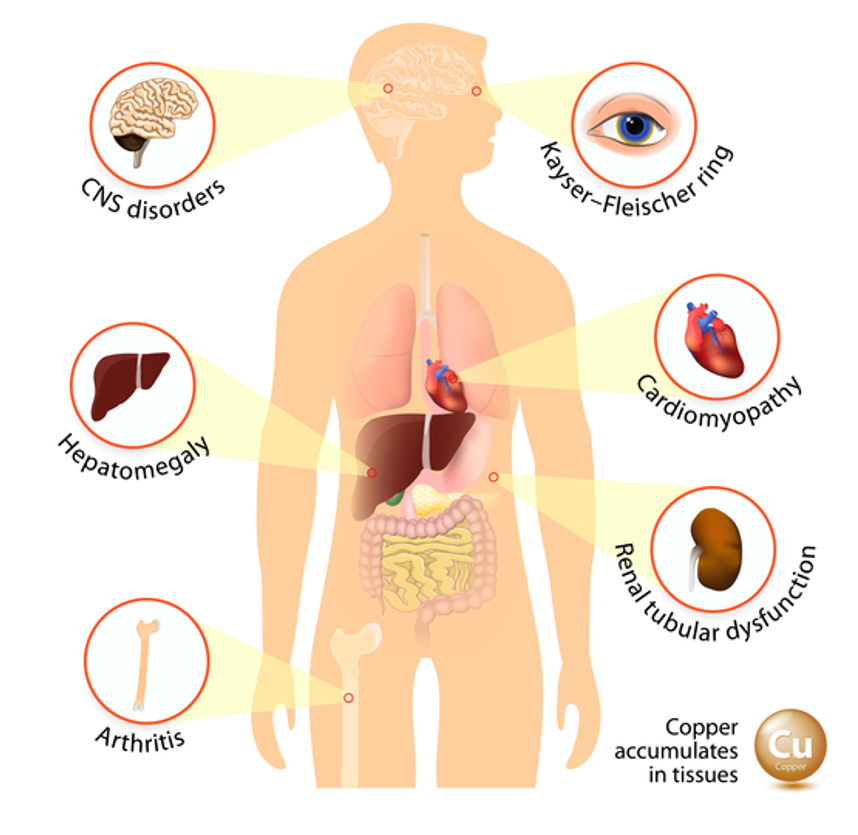Wilson’s Disease is a genetic disease characterised by the pathological progressive accumulation of copper in the body. It affects less than 0,01% of the population around the world.
Why does copper accumulates in these patients ?
In Wilson’s Disease, copper accumulates in some organs (mainly the liver) because of genetic mutations in the ATP7B copper transporter. In healthy individuals, ATP7B excretes copper from liver cells (hepatocytes) into bile ducts for removal. It also loads copper ions into a protein called ceruloplasmin which is then secreted into the blood to deliver copper to relevant body parts (because copper is an essential metal in the body function).
The deficiency in ATP7B results in an accumulation of particularly toxic copper (“free copper”) which is not ceruloplasmin-bound, mostly in the liver and the central nervous system. It is specifically that “bad free copper” that MexBrain extracts thanks to its technology, and not the good ceruloplasmin-bound copper.
1 / 30,000 people have Wilson Disease
25,000 patients in Europe and the US
First described in 1912 by Dr. Samuel Wilson
Wilson’s disease symptoms
- Fatigue, lack of appetite or abdominal pain
- A yellowing of the skin and the whites of the eye (jaundice)
- Golden-brown eye discoloration (Kayser-Fleischer rings)
- Fluid buildup in the legs or abdomen
- Problems with speech, swallowing or physical coordination
- Uncontrolled movements or muscle stiffness
- Scarring of the liver (cirrhosis). As liver cells try to make repairs to damage done by excess copper, scar tissue forms in the liver, making it more difficult for the liver to function.
- Liver failure. This can occur suddenly (acute liver failure), or it can develop slowly over years. A liver transplant might be a treatment option.
- Persistent neurological problems. Tremors, involuntary muscle movements, clumsy gait and speech difficulties usually improve with treatment for Wilson’s disease. However, some people have persistent neurological difficulty despite treatment.
- Kidney problems. Wilson’s disease can damage the kidneys, leading to problems such as kidney stones and an abnormal number of amino acids excreted in the urine.
- Psychological problems. These might include personality changes, depression, irritability, bipolar disorder or psychosis.
- Blood problems. These might include destruction of red blood cells (hemolysis) leading to anemia and jaundice.

Treatment
There is no cure for Wilson’s Disease (except for liver transplantation). Lifelong chelation treatment is usually needed to reduce the amount of copper in the body. Treatments exist to control the condition and may include:
- Taking medicines to help the body’s organs and tissues get rid of extra copper (copper-chelating medicines)
- Reducing the amount of copper ingested through food
- Taking zinc supplements. Zinc prevents the absorption of copper from the diet.
- Getting extra vitamin B6
- Taking medicines to treat symptoms such as muscle tremors or stiffness
- Getting a liver transplant, in case of severe liver damage
MexBrain is developing a new treatment against Wilson’s Disease in case of severe symptoms, aiming to remove specifically free copper from the blood with a dialysis machine and MEX-CD1. A clinical trial is ongoing in France (Lyon) and Spain (Barcelona). The objective is to remove fast enough and significantly enough copper in these patients to decrease acute symptoms and allow for a normal chronic oral chelation treatment afterwards.